There are 18 species of turtles in Oklahoma roaming the wild lands. The Sooner State is home to terrestrial specimens like the Ornate Box turtle and fully aquatic species such as Map turtles, and truly fascinating species like the Alligator Snapping turtle.
You can use this list as both a herping guide for identifying Oklahoma’s wild turtles and/or a starting point for choosing your next pet turtle.
If you’re planning on purchasing a turtle as a pet, understand that you can’t own Alligator Snapping, Western Chicken, or Northern Map turtles in Oklahoma. Also, you can only own up to 6 turtles at a time in the Sooner State.
Now that we’ve covered that, let’s find out about Oklahoma’s turtles.
Table of Contents
Box Turtles in Oklahoma
1. Ornate Box Turtle

- Experience Level: Intermediate to Expert
- Family: Emydidae
- Scientific Name: Terrapine ornata
- Other Names: Box Tortoise, Western Box Turtle
- Adult Size: 4 to 5 inches (10 to 12.5 cm)
- Life Span: 30 to 40 years
- Average Price Range: $150 to $450
- Conservation Status: Near threatened
Ornate Box turtles are a terrestrial species that inhabits open regions such as grasslands, prairies, and woodland areas. They prefer areas with loamy or sandy soil so they can easily burrow.
These turtles are common in the state of Oklahoma though in most other areas they are considered threatened and are protected. You may be able to see more Ornate Box turtles in western counties.
These turtles have dark brown colored, domed upper shells (carapace) with yellowish stripes, spots, and streaks. Their plastron (lower shell) is hinged which allows the turtle to pull itself completely inside its shell.
Their thick scaled legs and exposed skin is dark colored with yellow or orange spots and patterns. Males tend to have red eyes, while females have yellow to brown eyes.
Ornate Box turtles are difficult to keep in captivity because of their specialized diet and specific habitat needs. These turtles do best outdoors in large areas with proper substrate they can burrow into.
These turtles need to burrow in the ground when it’s hot outside, and when they need to increase their skin’s humidity.
2. Three-toed Box Turtle

- Experience level: Intermediate
- Family: Emydidae
- Scientific Name: Terrapene carolina triunguis
- Other Names: N/A
- Average Adult Size: 4.5 – 6.5 inches
- Life Span: 70+ years
- Average Price Range: $140 – $430
- Conservation Status: Vulnerable
Another terrestrial species, the Three-toed Box turtle roams Oklahoma’s woodlands, grasslands, thickets, and meadows. They also will burrow to escape the heat or to hide away through the winter.
As their name suggests, these turtles have 3 toes on the hind feet, though some have been known to grow a 4th toe on each foot. To better identify this turtle, look for a plain brown shell, with no patterns, or a brown shell with faded black or white markings.
Like all Box turtles, this species can withdraw into its shell for protection because the plastron is hinged and it will close tightly. Most turtle predators such as raccoons, dogs, and other small to medium sized mammals can’t get through the hard shell.
Even though they are terrestrial, it seems that Three-toed Box turtles do like to soak in the water. They can swim if they need to, but they are not adept and are quite clumsy when swimming. They won’t readily head into deep water, but they do like to hang out in the shallows often.
Three-toed Box turtles are omnivores who eat berries, nuts, seeds, plants, carrion, insects, worms, snails, beetles, and other small invertebrates.
Chicken Turtles in Oklahoma
3. Western Chicken Turtle

- Experience Level: Intermediate
- Family: Emydidae
- Scientific Name: Deirochelys Reticularia Miaria
- Other Names: N/A
- Adult Size: Between 4 and 10 inches
- Lifespan: Between 15 and 30 years
- Average Price Range: Between $180 and $300
- Conservation Status: Very rare in Oklahoma, considered secure nationally
The Western Chicken turtle can be identified by their oval shaped shell that’s wider at the back legs, and its very long neck. They also have a highly decorated carapace that’s olive, tan, or dark brown with an orange net-like pattern.
They have dark green skin with plenty of yellow stripes. While we are talking about physical characteristics, we have to note that females of this species are much larger than males. The girls are nearly double the size of the boys.
You’ll find Western Chicken turtles in ponds, marshes, and streams filled with vegetation. They feed on the plants in their habitat, but will occasionally consume snails, mollusks, insect larvae, and other small aquatic invertebrates.
These turtles are named so because of their egg shaped shells, and because they were hunted for food in the past. People who consumed these turtles said the meat tasted remarkably like chicken. I’ll take their word for it.
Cooters in Oklahoma
4. Eastern River Cooter
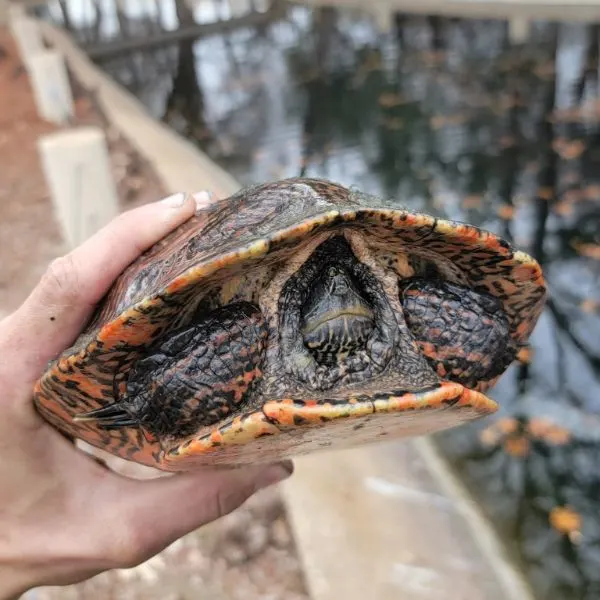
- Experience Level: Beginner to Intermediate
- Family: Emydidae
- Scientific Name: Pseudemys concinna concinna
- Other Names: River Cooter
- Adult Size: Between 8 and 12 inches
- Life Span: Between 20 and 40 years
- Average Price Range: $20 to $50
- Conservation Status: Special concern
Eastern River Cooters are found all over the eastern half of the state. They prefer waters that have abundant vegetation and places to hide. They are found in rivers, lakes, and reservoirs in shallow regions with plenty of plants.
If you see these turtles you’ll notice a brightly colored shell. The background is olive or dark brown, with orange, yellow, and black patterns. There are several forward and backward “C” shapes on the outer edge of the shell.
Juveniles have a central, serrated ridge along the carapace, but it flattens out as they age. Their skin is dark green or dark brown with yellow stripes much like other aquatic turtles.
They love to bask on large lily pads, fallen logs, or other areas above the water.
Eastern River Cooters are omnivores, but they consume mostly aquatic vegetation and algae. Occasionally they will feed on aquatic insects and small crustaceans.
Map Turtles in Oklahoma
5. Northern Map Turtle
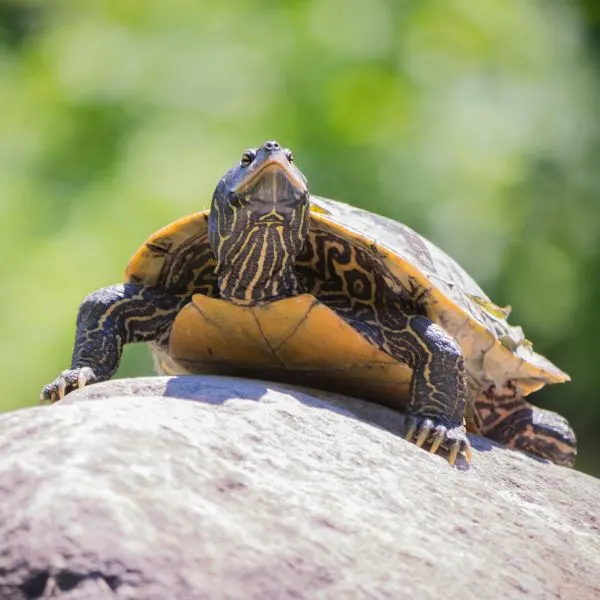
- Experience Level: Beginner
- Family: Emydidae
- Scientific Name: Graptemys geographica
- Other Name: Common map turtle
- Adult Size: Between 4 and 10 ½ inches
- Life Span: 15 to 20 years
- Average price range: Between $20 and $60
- Conservation Status: Least concern
There are several subspecies of Map turtles and they all have broad similarities. Most times you can identify individual subspecies by carefully inspecting the shell and markings on their heads. These turtles are notoriously skittish though, so distinct identification can prove difficult.
Map turtles have grey green to olive shells, and the majority of them have swirls and markings that resemble the contours on a map. They have a slightly flared shell with serrations at the rear edge, and most have a dark, raised ridge along the middle carapace.
Northern Map turtles are found in a few small populations in Oklahoma. Though this species is normally abundant, in the Sooner State they are quite rare and only found in the northeastern corner of the state.
To identify a Northern Map turtle, you’ll have to look for a pair of small white or yellow patches behind the eyes. These spots are relatively small, and often have a slight backward curve to them. If you can get close enough, you can also look at the plastron, which is pale and solid colored on Northern Map turtles.
This subspecies is found in small streams, creeks, and small rivers with gravelly bottoms. Here they hunt among the rocks looking for insects, fish eggs, crustaceans, and mollusks.
6. Mississippi Map Turtle

- Experience level: Intermediate – expert
- Family: Emydidae
- Scientific Name: Graptemys pseudogeographica kohni
- Other Names: Sawback Turtle
- Average Adult Size: 5 – 10 inches
- Life Span: 30 – 50 years
- Average Price Range: $30 – $130
- Conservation Status: Least Concern
Found in the eastern side of the state, the Mississippi Map turtle lives in reservoirs, lakes, rivers, and streams with plenty of basking spots. They can be identified by the central ridge that has 3 to 4 individual peaks on the upper shell. Along with the white or yellow stripes, you should see a series of “V” shaped stripes behind and below the eyes.
Another distinction is the fine stripes on the Mississippi Map turtle do not touch the eye. They also have dark green to brown shells with yellowish circular or swirled markings on the carapace.
These turtles feed mainly on crustaceans, insects, snails, and rarely aquatic plants.
7. Ouachita Map Turtle

- Experience Level: Beginner
- Family: Emydidae
- Scientific Name: Graptemys ouachitensis
- Other Names: Southern Map turtle
- Adult Size: 3.5 to 10 inches (9 to 25.5 cm)
- Life Span: 15 to 20 years
- Average Price Range: $40 to $100
- Conservation Status: Least concern
To identify the Ouachita Map turtle you have to look closely at the head. They have the same ridge, shell color, and skin markings as the other Oklahoma Map turtles. This species also lives in the eastern side of the state.
When looking at the markings on the head, look for small, circular spots under the eyes, and on the lower jaw. They also have larger, elongated patches of white or yellow behind the eyes that sometimes resemble an “L” or “7”. You’ll also see that 3 or more stripes lead up to the eye, but stop at the eyelid.
Ouachita Map turtles consume mostly plants, but they have been observed eating snails, small clams and mussels, and insects.
Mud Turtles in Oklahoma
8. Mississippi Mud Turtle

- Experience level: Intermediate
- Family: Kinosternidae
- Scientific Name: Kinosternon subrubrum hippocrepis
- Other Names: N/A
- Average Adult Size: 5 – 7 inches
- Life Span: 25 – 45 years
- Average Price Range: $40 – $80
- Conservation Status: Least Concern
Mississippi Mud turtles are small, mostly non-descript turtles. They have an oval, high-domed shell that’s flattened on the top, and drops down sharply at the sides and back. It’s usually dark brown in color and has no pattern. The skin on these turtles is dark grey with a stripe running behind the eyes.
They rarely exceed 5 to 6 inches and are not often seen because they spend most of their time at the bottom of small, shallow ponds and waters. They prefer slow moving to stagnant waters with abundant vegetation and soft substrate.
All turtles of the Kinosternidae family have glands at the back that can produce a pungent, foul smelling musk when the turtle is threatened or handled roughly.
Mississippi Mud turtles are omnivores that feed on slow moving aquatic organisms. These include tadpoles, crayfish, snails, and insects. They also feed on vegetation and algae.
9. Yellow Mud Turtle
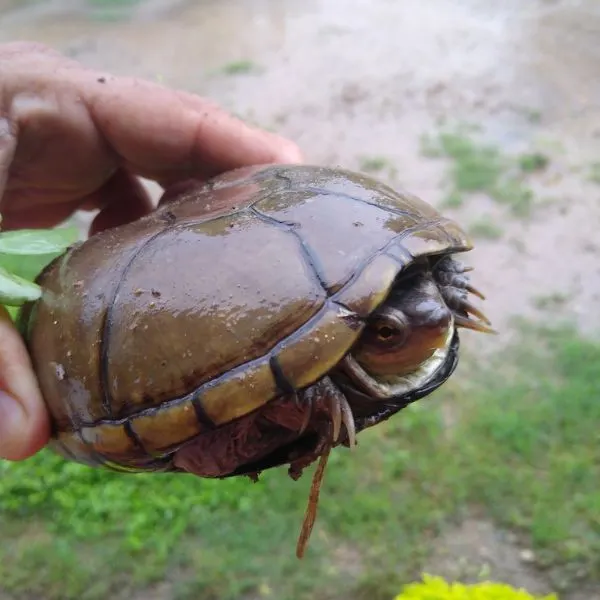
- Experience level: Intermediate
- Family: Kinosternidae
- Scientific Name: Kinosternon flavescens
- Common Name: Mud Turtle, Yellow Mud Turtle
- Average Adult Size: 5 – 7 inches
- Life Span: 40 years
- Average Price Range: Approximately $80 to $300
- Conservation Status: Conservation Status: Federally listed as least concern, but threatened or endangered in most states.
Nationally, the Yellow Mud turtle is listed as a species of least concern, but nearly every state this turtle lives in lists it as threatened or endangered. These turtles inhabit temporary farm ponds, agriculture waterways, and wetlands, but are losing habitat because of cattle grazing and increased agricultural lands.
The Yellow Mud turtle stays in these waters until winter comes, and then they bury themselves in the mud and hibernate until warm weather returns.
Their shells are similarly shaped to the Mississippi Mud turtle but are mostly olive colored. Their skin is green on the upper side, and pale yellow on the underside.
Their diet consists of snails, crayfish, insects, and vegetation. What they eat is mostly reliant on what’s available in the small waterways they call home.
Musk Turtles in Oklahoma
10. Eastern Musk Turtle
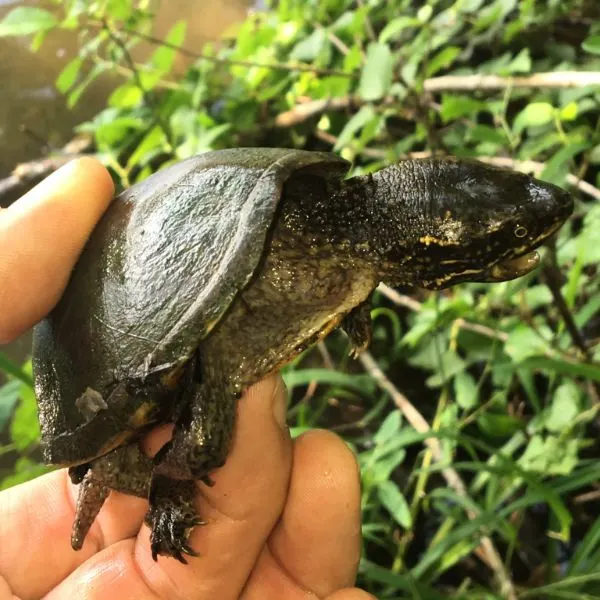
- Experience Level: Intermediate
- Family: Kinosternidae
- Scientific Name: Sternotherus odoratus
- Other Names: Common Musk turtle, Stinkpot
- Adult Size: 4 to 5 inches (10 to 12.5 cm)
- Life Span: 30 to 50 years
- Average Price Range: $30 to $120
- Conservation Status: Least concern
Though the Eastern Musk turtle’s cousins can do the same trick of secreting musk to assault the nostrils, this turtle gets the moniker “Stinkpot.” Maybe they’re more likely to unleash the stink?
Like other musk and mud turtles, they have a distinctive oval, domed shell with a single, solid color. Their skin is dark, but they have a pair of white or yellow stripes that start at the snout and travel behind the head. They spread above and below the eyes and often go along the neck too.
These turtles like shallow waters with soft or muddy substrates and a lot of vegetation. While they are mostly aquatic, they aren’t great swimmers. Instead, the Musk turtle will use the plants to climb up to the surface for air, or they will even climb into trees if the branches dip low enough.
Eastern Musk turtles are mostly nocturnal and spend their nights looking for food. They will eat aquatic organisms such as crayfish, snails, tadpoles, and some plants. On land or in the trees they will feed on spiders, worms, and insects.
11. Razorback Musk Turtle

- Experience level: Beginner
- Family: Kinosternidae
- Scientific Name: Sternotherus Carinatus
- Other Names: Razor-Backed musk turtle, Mississippi Musk turtle
- Average Adult Size: 5 – 6 inches
- Life Span: 20 – 30 years
- Average Price Range: Approximately $80 – 160
- Conservation Status: Least Concern
This turtle is the most ornate of the mud and musk turtles found in Oklahoma. They have dark brown ridged shells with light brown and black patterns. The top of the shell has ridged, overlapping scutes that resemble saw teeth.
Their skin is dark green or brown with speckles, spots, and a few stripes.
These turtles are often found in rocky bottomed streams, unlike their cousins that prefer soft, muddy bottoms.
Razorback Musk turtles feed on aquatic insects, crustaceans, and vegetation.
Painted Turtles in Oklahoma
12. Southern Painted Turtle
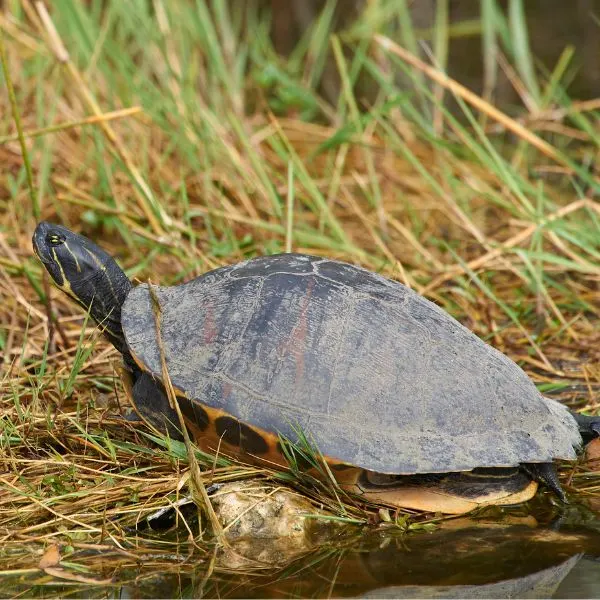
- Experience level: Beginner
- Family: Emydidae
- Scientific Name: Chrysemys dorsalis
- Other Names: Painted Turtle
- Average Adult Size: 4 – 6 inches
- Life Span: 20 – 25 years
- Average Price Range: $30 – $150
- Conservation Status: Least Concern
Southern Painted turtles are the smallest subspecies of Painted turtles. Aside from the small size, you can easily identify these turtles by the red or orange strip that extends down the middle of the carapace.
They have smooth shells with easy to distinguish scutes. The carapace is dark green to nearly black, is slightly domed, and looks aerodynamic. All Painted turtles have dark brown to almost black skin with yellow, orange, and/or red stripes.
Southern Painted turtles are found in the southeastern corner of the state in streams, ponds, and small lakes. Here they feed on both aquatic animals and plants.
13. Western Painted Turtle
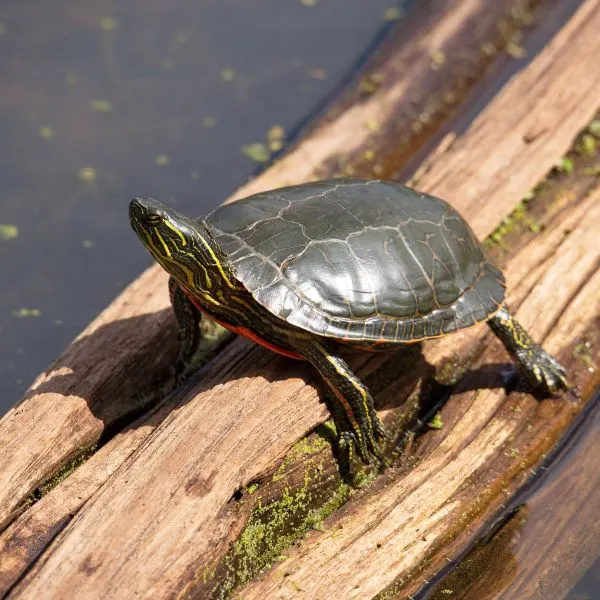
- Experience Level: Beginner
- Family: Emydidae
- Scientific Name: Chrysemys Picta Belli
- Other Names: N/A
- Adult Size: Between 4 and 10 inches
- Life Span: Between 30 and 50 years
- Average Price Range: Between $30 and $150
- Conservation Status: Least concern
The Western Painted turtle grows slightly larger than the Southern Painted turtle and is found along the northern section of the state bordering Kansas. This Painted turtle doesn’t like rapid currents and will seek out sloughs, ponds, slow moving rivers, and swamps.
These turtles have a solid colored upper carapace, but the outer edge often called the bridge of the shell, is bright red with dark patterns. This bright coloration continues to the plastron. There is a black, brown, and dark blue “butterfly” pattern on the bottom of the shell.
Western Painted turtles feed on leeches, fish, crayfish, insects, and mollusks as well as vegetation. Juveniles consume more protein sources, while adults feed more on vegetation.
Pond Sliders in Oklahoma
14. Red Eared Slider
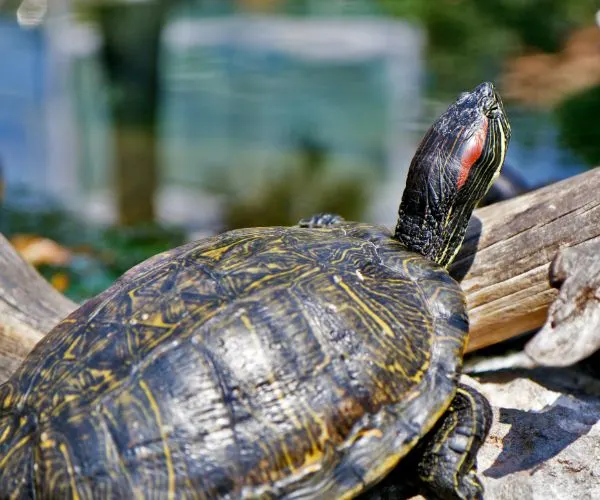
- Experience level: Beginner
- Family: Emydidae
- Scientific Name: Trachemys scripta elegans
- Common Name: Pond slider, Red-eared terrapin, Water slider
- Average Adult Size: 6 – 8 inches
- Life Span: 20 to 40 years
- Average Price Range: approximately $30 to $100
- Conservation Status: Least concern
Red Eared Sliders are native to Oklahoma, though they can become invasive quickly in nearly any other habitat.
You’ll recognize these turtles by their brightly colored carapace. When they are young, the shell is bright green, yellow, orange, brown, and black. As the turtle ages, these swirls and patterns grow darker.
Their skin is olive to dark brown with abundant yellow stripes. The most distinguishing mark is the pair of red patches just behind the eyes.
Red Eared Sliders are excellent swimmers, but they prefer slow-moving waters of rivers, lakes, reservoirs, and large ponds. They love to bask and will often pile up together, or crowd other species off of basking spots.
These turtles are opportunistic feeders and will eat anything, including carrion, fish, crustaceans, amphibians, mollusks, vegetation, algae, as well as worms, and insects.
Snapping Turtles in Oklahoma
15. Alligator Snapping Turtle

- Experience level: Expert
- Family: Chelydrida
- Scientific Name: Macrochelys temminckii
- Common Name: Loggerhead Snapper
- Average Adult Size: 13-30 inches
- Life Span: 30 – 50 years
- Average Price Range: Approximately $50 to $300
- Conservation Status: Threatened
Alligator Snapping turtles look like animals that time forgot. They have spiked, ridged shells, spiked tails, spiked limbs, and fleshy spikes all over their skin. These turtles are the second largest freshwater turtle in the world. The largest belongs to a critically endangered softshell turtle found only in Asia.
Aside from their spiky appearance, these turtles are mostly brown, or dark green both on their carapace and skin.
You could be living around these turtles all your life but never see one because they rarely leave the water. These huge, lethargic turtles like to chill at the bottom of the water with their mouths open. They have a wormy projection on their tongues that wiggles and entices fish and other prey to get close.
When anything small enough to gulp down in a bite or two gets close, the turtle clamps down and eats it.
Alligator Snapping turtles reside in large bodies of water, especially if there is ample tree cover. Since they don’t like to travel over land, you won’t typically find these huge beasts in ponds or temporary pools.
This big turtle is mostly carnivorous. They will eat anything that gets near, including frogs, tadpoles and other amphibians, fish, crayfish, and even small turtles.
16. Common Snapping Turtle
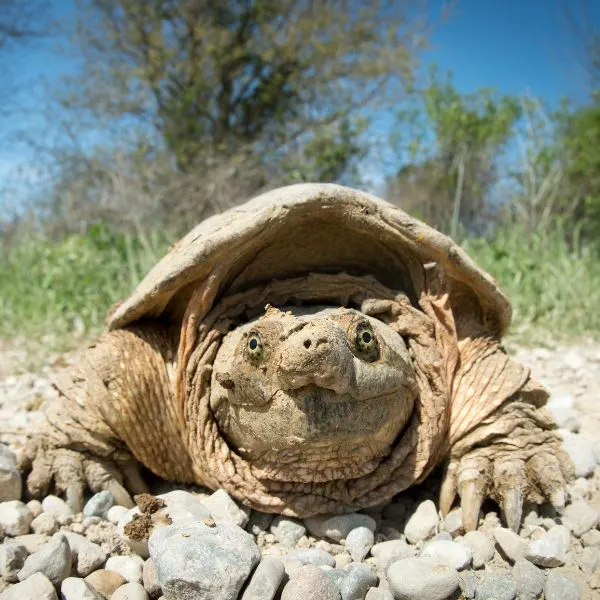
- Experience level: Intermediate to Expert
- Family: Chelydrida
- Scientific Name: Chelydra Serpentina
- Other Names: Snapping Turtle, Snapper, Eastern Snapping Turtle
- Average Adult Size: 8 to 20 inches
- Life Span: 30 – 50 years
- Average Price Range: Approximately $40 to $120
- Conservation Status: Least concern
The smaller, but no less intimidating cousin of the Alligator Snapping turtle can be found in every county of Oklahoma. They are found in rivers, lakes, permanent ponds, streams, and reservoirs.
One of the reasons the Common Snapping turtle is found all across the state is because females can travel vast distances searching for sandy nesting sites near water. Males tend to stay in the same place though.
To identify the Common Snapping turtle, look for a smoother shell with slight ridges, and a more saw-toothed tail. These turtles have a hooked beak on a long neck and have thick limbs.
Their shell is dark brown to black but may be covered in mud or algae. Their skin can be dirty yellow to dark brown.
Common Snapping turtles feed on fish, crayfish, amphibians, and small turtles. They feed on vegetation here and there. Though they have a bad reputation for feeding on waterfowl, they only do so very rarely and they will not actively hunt them down. It has to be the perfect opportunity.
Softshell Turtles in Oklahoma
17. Midland Smooth Softshell Turtle

- Experience level: Intermediate
- Family: Trionychidae
- Scientific Name: Apalone Mutica
- Other Names: N/A
- Average Adult Size: 5 – 14 inches
- Life Span: 10 – 20 years
- Average Price Range: $50 – $150
- Conservation Status: Least Concern
Smooth Softshell turtles are very flat turtles that do not have a hard covering. Instead, they have thick, tough skin that covers their internal organs. They are olive to brown in color and have a few dark spots or blotches on the carapace.
They have long necks that are usually withdrawn and have long snouts. They like to inhabit shallow, sandy bottomed waters where they can bury themselves and just reach out with their long necks to breathe.
Midland Smooth Softshell turtles are found in streams and rivers with sandy bottoms. They have wide, webbed feet to help them navigate the strong currents.
Midland Smooth Softshell turtles feed mostly on fish, crayfish, mollusks, and insects.
18. Spiny Softshell Turtle
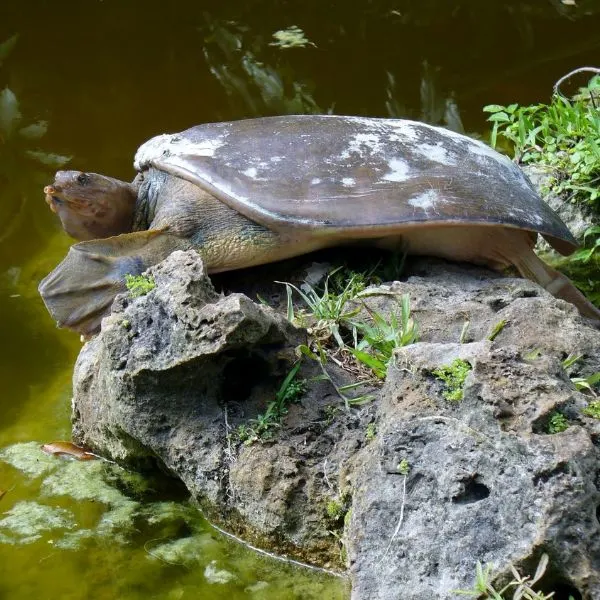
- Experience Level: Intermediate to Expert
- Family: Trionychidae
- Scientific Name: Apalone spinifera
- Other Names: N/A
- Adult Size: 5 to 9 ½ inches for males, 10 to 17 inches for females
- Life Span: Between 20 and 50 years
- Average Price Range: Between $20 and $120
- Conservation Status: Threatened in some areas
Spiny Softshell turtles are very similar to the previously mentioned Smooth Softshell turtle. They look similar and inhabit the same sandy bottomed waters. The biggest differences are the ridge of fleshy spikes on the Spiny Softshell, and the size.
Spiny Softshell turtles in Oklahoma grow larger than Smooth Softshells. Female Softshell turtles are much bigger than males.
These turtles are mostly carnivorous as well. They feed on fish, amphibians, insects, worms, snails, and slugs. When these foods aren’t available, they will feed on vegetation.
FAQs
What are the biggest Oklahoma turtles?
There are several big turtles in Oklahoma, but the biggest goes to the Alligator Snapping turtle. These big turtles can reach carapace lengths exceeding 2 feet long. The Common Snapping turtle and Spiny Softshell turtle are the next biggest turtles found in Oklahoma.
Are turtles illegal in Oklahoma?
You can keep pet turtles in Oklahoma, but there are a few restrictions. Terrestrial turtles such as Box turtles cannot be sold in the state. There are also restrictions on owning Chicken turtles, Alligator Snapping turtles, and Northern Map turtles.
You may also have to obtain a special permit to buy or sell turtles. Be sure to contact your local law agency or fish and wildlife agency for more information.
Are Alligator Snapping turtles protected in Oklahoma?
There are currently 3 protected turtle species in Oklahoma, they are the Alligator Snapping Turtle, Western Chicken turtle, and Northern Map turtle.
Conclusion
You hung in there through all 18 turtle species found in Oklahoma. What did you think? What’s your favorite among them all? Is it the big Alligator Snapping turtle, or the tiny Stinkpot? Do you prefer the floppy softshell turtles or terrestrial Box turtles?
Let us know and connect with other fellow turtle enthusiasts by dropping us a comment below. Until next time, peace, love, and turtles!
Other nearby states
